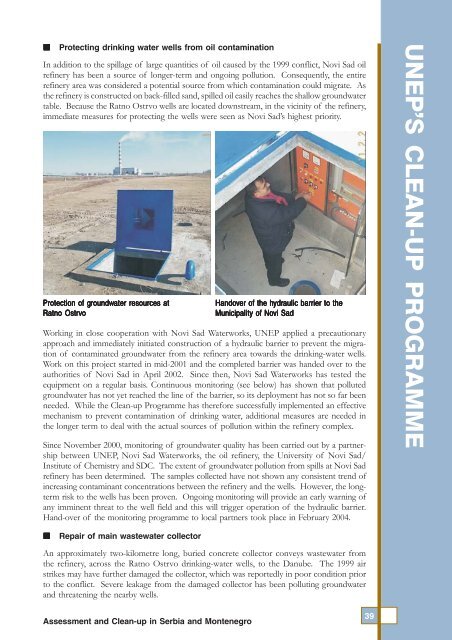From Conflict to Sustainable Development From Conflict to ...
From Conflict to Sustainable Development From Conflict to ...
From Conflict to Sustainable Development From Conflict to ...
Create successful ePaper yourself
Turn your PDF publications into a flip-book with our unique Google optimized e-Paper software.
Protecting drinking water wells from oil contamination<br />
In addition <strong>to</strong> the spillage of large quantities of oil caused by the 1999 conflict, Novi Sad oil<br />
refinery has been a source of longer-term and ongoing pollution. Consequently, the entire<br />
refinery area was considered a potential source from which contamination could migrate. As<br />
the refinery is constructed on back-filled sand, spilled oil easily reaches the shallow groundwater<br />
table. Because the Ratno Ostrvo wells are located downstream, in the vicinity of the refinery,<br />
immediate measures for protecting the wells were seen as Novi Sad’s highest priority.<br />
Protection of groundw<br />
roundwater resources at<br />
Ratno Ostrvo<br />
Handover of the hydr<br />
ydraulic barrier <strong>to</strong> the<br />
Municipality of Novi Sad<br />
Working in close cooperation with Novi Sad Waterworks, UNEP applied a precautionary<br />
approach and immediately initiated construction of a hydraulic barrier <strong>to</strong> prevent the migration<br />
of contaminated groundwater from the refinery area <strong>to</strong>wards the drinking-water wells.<br />
Work on this project started in mid-2001 and the completed barrier was handed over <strong>to</strong> the<br />
authorities of Novi Sad in April 2002. Since then, Novi Sad Waterworks has tested the<br />
equipment on a regular basis. Continuous moni<strong>to</strong>ring (see below) has shown that polluted<br />
groundwater has not yet reached the line of the barrier, so its deployment has not so far been<br />
needed. While the Clean-up Programme has therefore successfully implemented an effective<br />
mechanism <strong>to</strong> prevent contamination of drinking water, additional measures are needed in<br />
the longer term <strong>to</strong> deal with the actual sources of pollution within the refinery complex.<br />
Since November 2000, moni<strong>to</strong>ring of groundwater quality has been carried out by a partnership<br />
between UNEP, Novi Sad Waterworks, the oil refinery, the University of Novi Sad/<br />
Institute of Chemistry and SDC. The extent of groundwater pollution from spills at Novi Sad<br />
refinery has been determined. The samples collected have not shown any consistent trend of<br />
increasing contaminant concentrations between the refinery and the wells. However, the longterm<br />
risk <strong>to</strong> the wells has been proven. Ongoing moni<strong>to</strong>ring will provide an early warning of<br />
any imminent threat <strong>to</strong> the well field and this will trigger operation of the hydraulic barrier.<br />
Hand-over of the moni<strong>to</strong>ring programme <strong>to</strong> local partners <strong>to</strong>ok place in February 2004.<br />
UNEP’S CLEAN-UP PROGRAMME<br />
<br />
Repair of main wastewater collec<strong>to</strong>r<br />
An approximately two-kilometre long, buried concrete collec<strong>to</strong>r conveys wastewater from<br />
the refinery, across the Ratno Ostrvo drinking-water wells, <strong>to</strong> the Danube. The 1999 air<br />
strikes may have further damaged the collec<strong>to</strong>r, which was reportedly in poor condition prior<br />
<strong>to</strong> the conflict. Severe leakage from the damaged collec<strong>to</strong>r has been polluting groundwater<br />
and threatening the nearby wells.<br />
Assessment and Clean-up in Serbia and Montenegro<br />
39

















